Metastatic Cancer Treatment Market Size
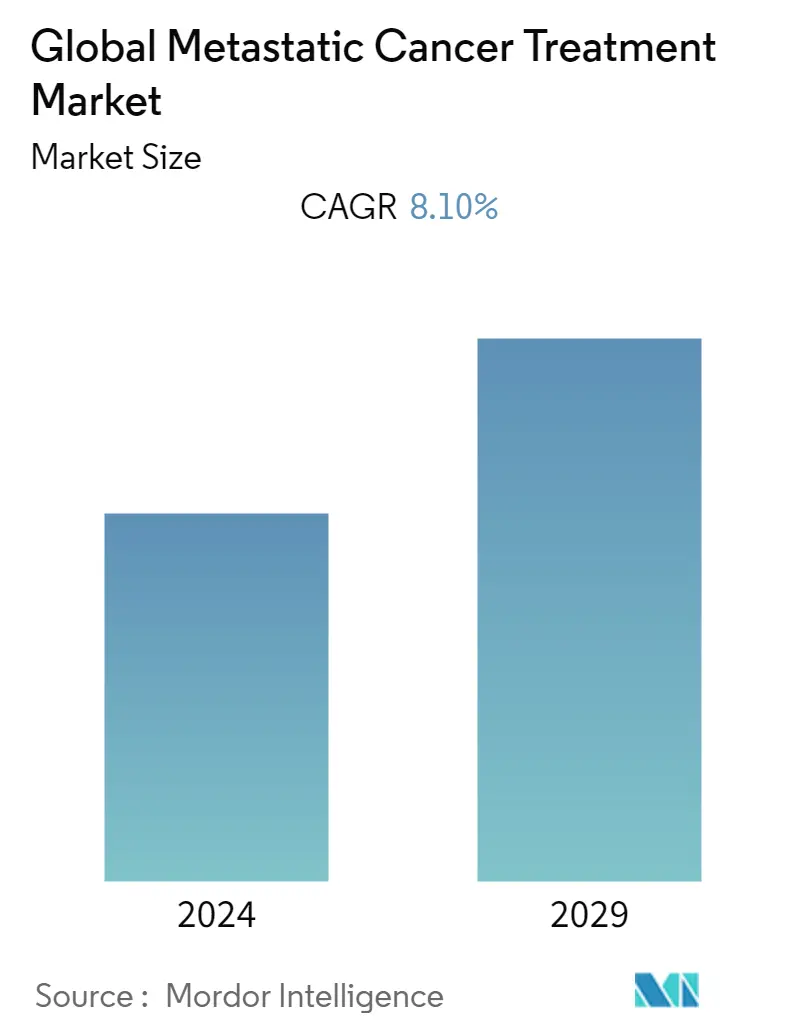
| Study Period | 2019 - 2029 |
| Base Year For Estimation | 2023 |
| Forecast Data Period | 2024 - 2029 |
| CAGR | 8.10 % |
| Fastest Growing Market | Asia-Pacific |
| Largest Market | North America |
Major Players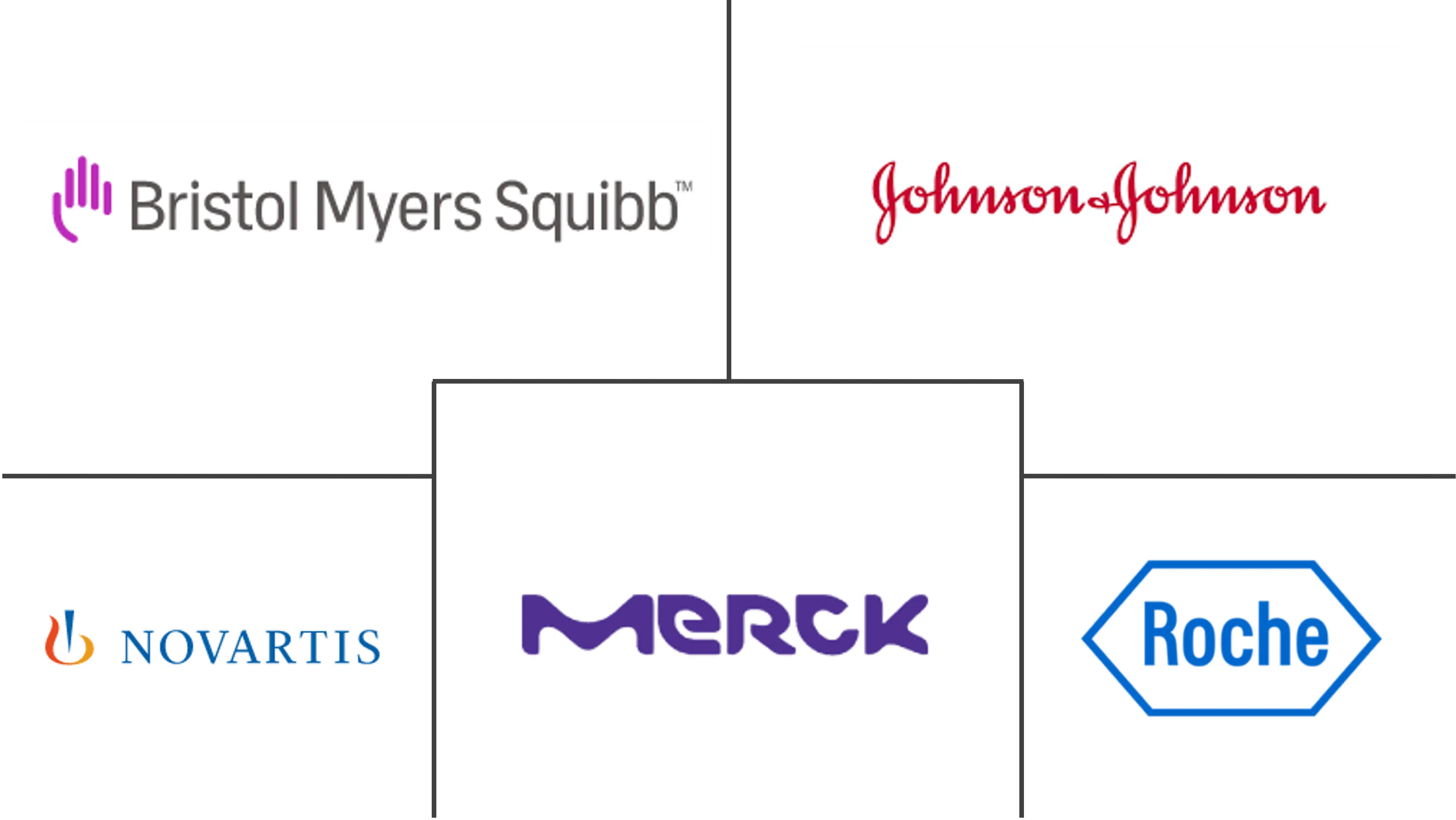
*Disclaimer: Major Players sorted in no particular order |
Metastatic Cancer Treatment Market Analysis
The metastatic cancer treatment market is expected to register a CAGR of 8.1% over the forecast period, 2022-2027.
The COVID-19 pandemic delayed treatment for patients seeking care for life-threatening conditions, including cancer. The strict lockdowns and government regulations intended to slow down the spread of COVID-19 resulted in a decrease in the diagnosis and treatment of metastatic cancer patients. Additionally, the severity of metastatic cancer has grown dramatically owing to the decline in hospital visits. It is also anticipated that treatment interruptions will reduce the likelihood that people with cancer will survive in the future. For instance, according to a study "Exploring metastatic breast cancer treatment changes during COVID-19 pandemic", it was observed that measures were undertaken to reduce access to hospitals for cancer patients in countries where the COVID-19 cases were massive, such as in Italy, which created a gap in between regular appointments. Moreover, elective surgeries, follow-up appointments, and initial cancer treatments were canceled or postponed, prioritizing hospital beds and care for those patients who were extremely affected by COVID-19. However, the metastatic cancer treatment market growth observed a significant increase in the later stages of the pandemic owing to the surge in metastatic cancer cases among the population. Thus, the COVID-19 outbreak affected the market's growth adversely in its preliminary phase; however, the market is expected to gain traction due to the significant increase in research and development of metastatic cancer treatment drugs.
Furthermore, the increasing prevalence of metastatic cancer, the surge in research and development activities, identification of new cancer drugs, and growing demand for stem cell therapy to treat metastatic cancer are boosting the growth of the studied market.
A growing patient population is likely to have a positive impact on the growth of the market over the coming years. For instance, according to Susan G. Komen Metastatic Breast Cancer Organization estimates in 2020, more than 168,000 women are living with metastatic breast cancer in the United States. Likewise, as per the data published by the American Cancer Society's Cancer Facts & Figures 2020, more than 90% of cancer-related deaths are caused by metastasis. After a person receives a successful course of therapy, annual tests, and/or five, ten, or more years after diagnosis, metastatic cancer may still develop.
Moreover, a surge in the number of strategic initiatives such as product approvals and developments, mergers and acquisitions, and joint ventures among the key market players is also anticipated to drive the market growth throughout the forecast period. For instance, in February 2022, AstraZeneca and Daiichi Sankyo's Enhertu received Food and Drug Administration approval, which is a prescription drug used to treat metastatic breast cancer and metastatic stomach cancer called gastroesophageal junction (GEJ) adenocarcinoma.
Therefore, owing to the aforementioned factors, the studied market is anticipated to witness growth over the analysis period. However, the high cost of oncology treatment is likely to impede the market's growth.
Metastatic Cancer Treatment Market Trends
This section covers the major market trends shaping the Metastatic Cancer Treatment Market according to our research experts:
Chemotherapy Segment is Expected to Witness Growth Over the Forecast Period
The chemotherapy segment is expected to register a significant growth rate owing to factors such as the surge in research and development of chemotherapy medicines specifically for metastatic cancers and the increasing adoption of chemotherapy among the patient population.
For instance, a report titled, "Cancer Treatment and Survivorship Facts & Figures" published by the American Cancer Society in 2020 stated that 56% of women diagnosed with metastatic breast disease (stage IV) typically receive radiation and chemotherapy without surgery. As per the same source stated above, chemotherapy is the most common treatment for metastatic colon or rectal cancer, and 66% of stage III colon cancer patients are treated with adjuvant chemotherapy. The standard treatment for acute myeloid leukemia is two phases of chemotherapy. Most diffuse large B-cell lymphoma (DLBCL) patients receive chemotherapy (82%), either with (43%) or without (39%) immunotherapy. Moreover, the same source also stated that only 18% of patients with stage III Non-Small Cell Lung Carcinoma (NSCLC) undergo surgery while most (63%) are treated with chemotherapy and/or radiation.
Additionally, when an estrogen-receptor-positive tumor becomes resistant to hormonal treatments like tamoxifen or aromatase inhibitors, chemotherapy is typically advised as the first-line metastatic cancer treatment. Chemotherapy is recommended for patients who are estrogen receptor-negative and have cancers that are HER2 positive, along with targeted therapy like Herceptin. Moreover, for malignancies that are HER2 and estrogen receptor-negative (triple-negative breast cancers), chemotherapy is one of the best suitable treatments for these individuals. Such factors are likely to boost the adoption of chemotherapy treatment among cancer patients.
Furthermore, in December 2020, SWOG Cancer Research Network researchers demonstrated that a triple-drug combination of irinotecan, cetuximab, and vemurafenib is a more potent tumor combatant and keeps people with metastatic colon cancer disease-free for a significantly longer period of time than patients treated with irinotecan and cetuximab. SWOG Cancer Research Network is a cancer clinical trials group funded by the National Cancer Institute (NCI), part of the National Institutes of Health.
Hence, owing to the aforesaid factors, the chemotherapy segment is expected to project significant growth over the forecast period.
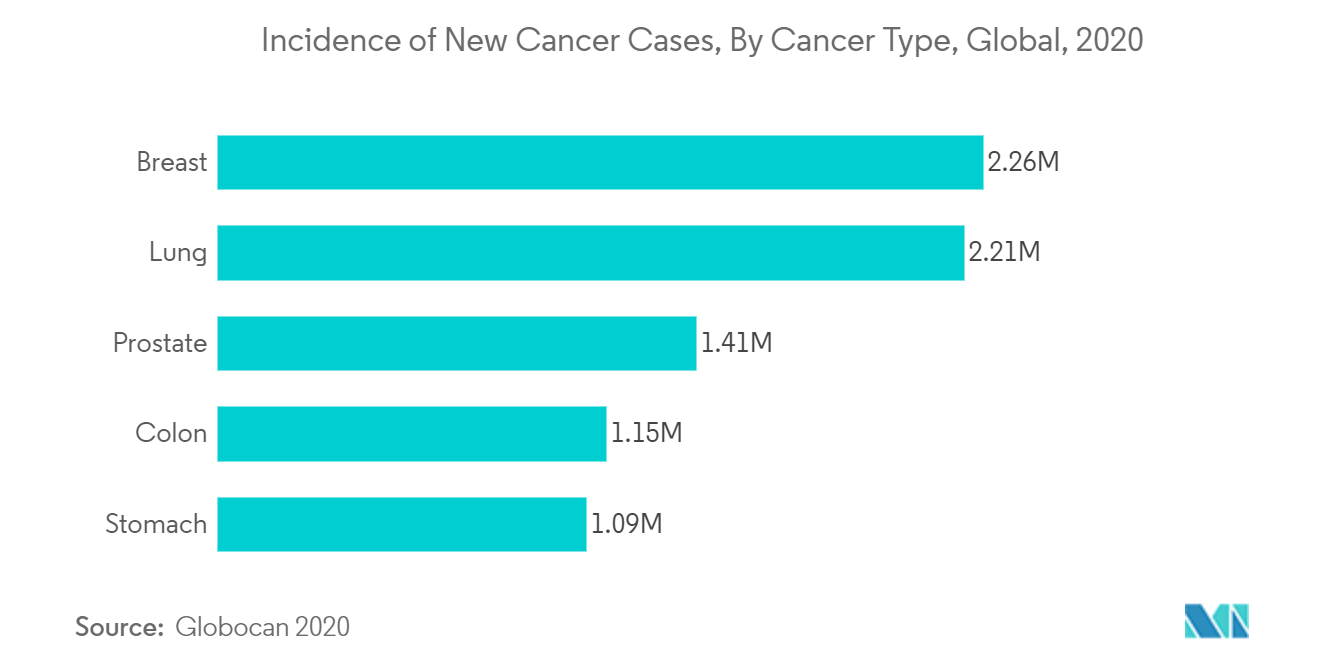
North America is Expected to Dominate the Metastatic Cancer Treatment Market
North America is expected to hold a major share of the market owing to factors such as the high prevalence of metastatic cancer, a surge in research and development, identification of new drugs to treat metastatic cancer, and the availability of advanced diagnosis infrastructure.
According to the American Institute of Cancer Research, in 2020, metastatic cancer accounts for up to 90% of cancer deaths each year in the United States, and 6% of women were diagnosed with metastatic breast cancer in the first diagnosis. According to MetaVivor, a government-funded Metastatic Breast Cancer Research, Support, and Awareness Group, in 2020 stated that 1 in 8 women was diagnosed with breast cancer in the United States, and 1 in 3 of those would become metastatic. The same source further stated that among American women and men, there were 268,600 new cases of advanced breast cancer and 41,760 breast cancer deaths. Of those deaths, nearly 97-99% were from metastatic breast cancer.
Moreover, growing strategic developments such as therapy launches, acquisitions, and mergers among prominent players are anticipated to drive market growth. For instance, in August 2021, GSK received US-FDA accelerated approval for JEMPERLI (dostarlimab-gxly) for adult patients with mismatch repair-deficient recurrent or advanced solid tumors. Similarly, according to the small clinical trial, conducted by the Memorial Sloan Kettering Cancer Center, New York, 18 rectal cancer patients who had mismatch repair deficiency took Dostarlimab for around six months, which resulted in the complete eradication of tumors without any additional treatment in all 100 of them. The drug is still being studied, and the trial is limited to patients with a specific type of rectal cancer, which accounts for about 4 to 5 percent of all rectal cancers.
Additionally, in March 2022, the United States Food and Drug Administration approved Pluvicto for the treatment of adult patients with advanced cancer called prostate-specific membrane antigen-positive metastatic castration-resistant prostate cancer (PSMA-positive mCRPC) that has spread to other parts of the body.
Therefore, owing to the aforementioned factors, the growth of the studied market is anticipated in the North American region.
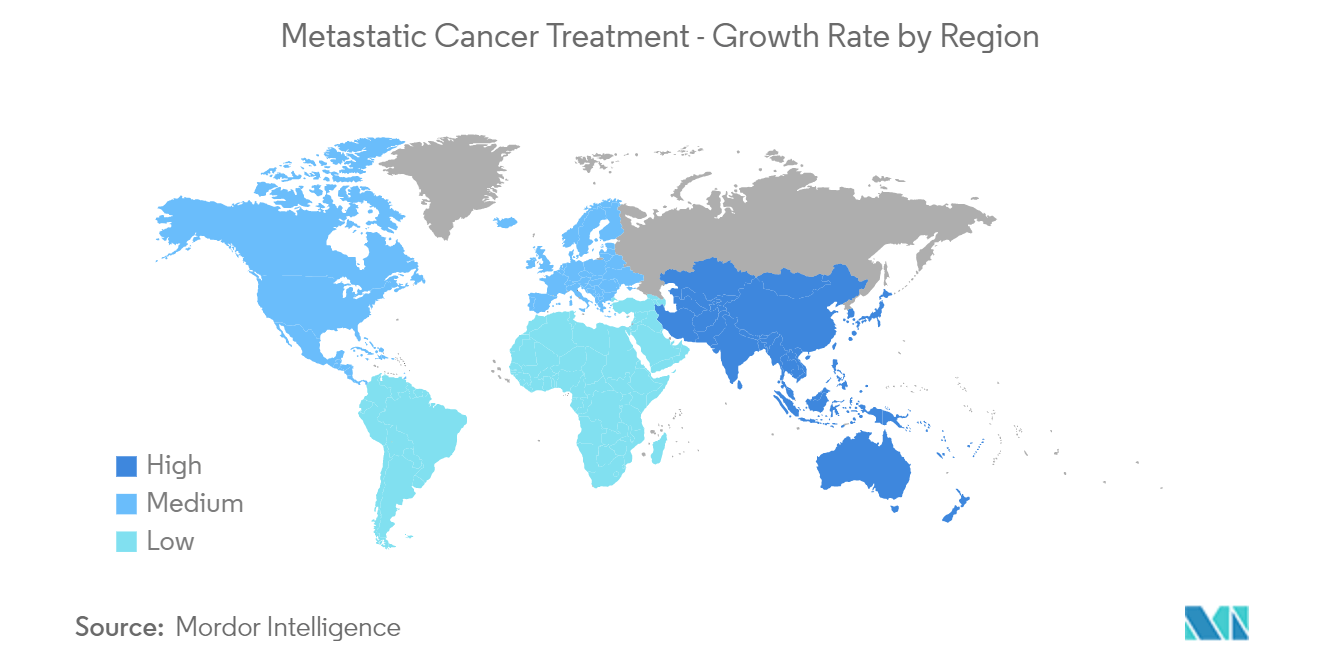
Metastatic Cancer Treatment Industry Overview
The metastatic cancer treatment market is competitive in nature due to the presence of several companies operating globally as well as regionally. The competitive landscape includes an analysis of a few international as well as local companies that hold the market share and are well known. Some of the major players include Bristol Myers Squibb Company, Celgene, Roche, Merck and Co., Johnson & Johnson Services Inc, GlaxoSmithKline Plc, AstraZeneca, Lilly, Novartis AG, Pfizer Inc, AbbVie Inc, and Amgen Inc, among others.
Metastatic Cancer Treatment Market Leaders
-
Bristol Myers Squibb Company
-
Merck and Co Inc.
-
Johnson & Johnson Services Inc
-
Novartis AG
-
F. Hoffmann-La Roche Ltd
*Disclaimer: Major Players sorted in no particular order
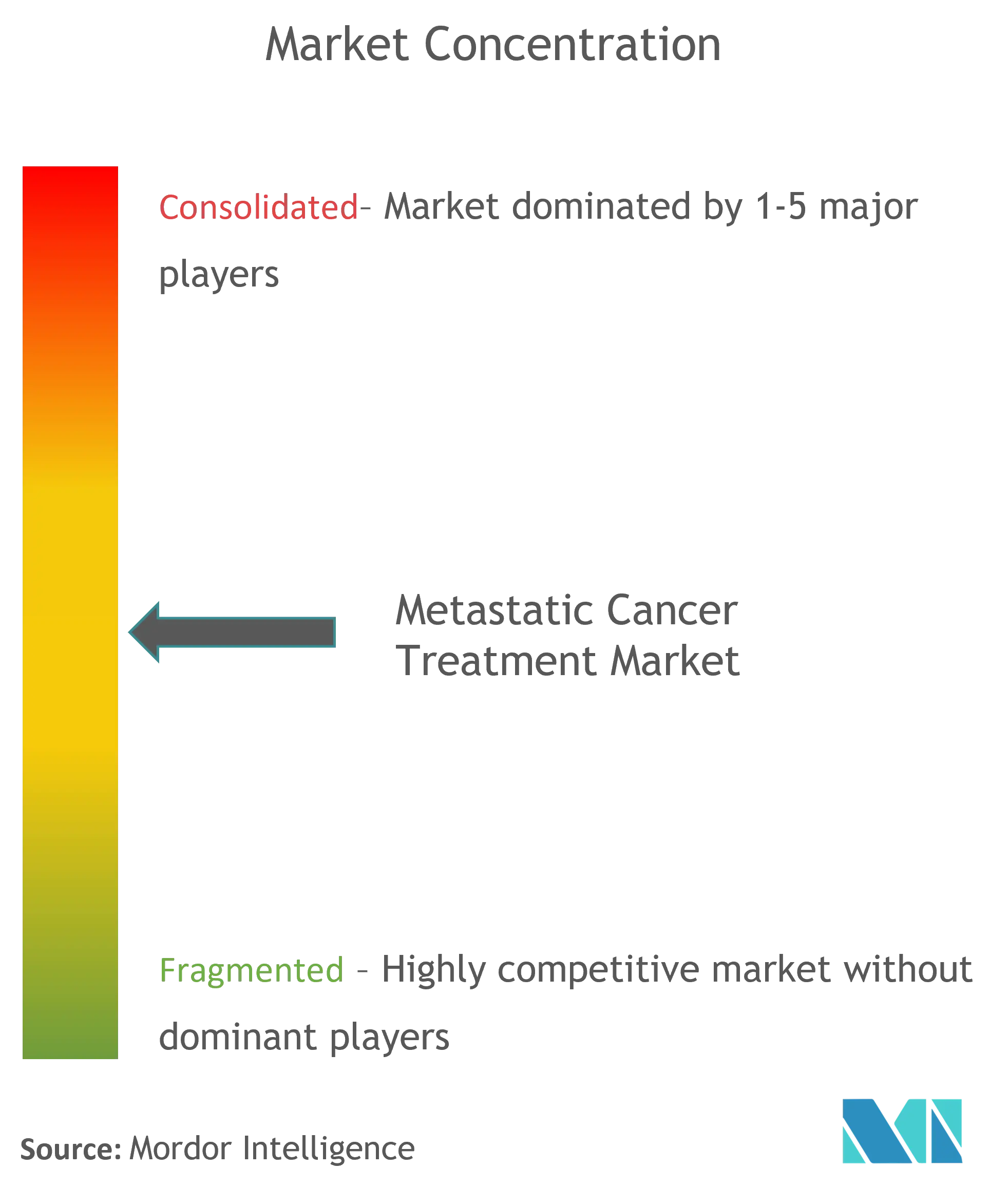
Metastatic Cancer Treatment Market News
In June 2022, the FDA approved Novartis' Dabrafenib and Trametinib combination for the treatment of adult and pediatric patients with unresectable metastatic solid tumors who harbor a BRAF mutation. BRAF is a human gene that encodes a protein called B-Raf. The gene is also referred to as proto-oncogene B-Raf and v-Raf murine sarcoma viral oncogene homolog B.
In May 2022, the European Commission (EC) approved Bristol Myers Squibb's Opdivo (nivolumab) in combination with Yervoy (ipilimumab) for the first-line treatment of adult patients with unresectable advanced, recurrent or metastatic esophageal squamous cell carcinoma (ESCC). The EC's decision was based on results from the Phase 3 clinical trials, which were presented at the American Society of Clinical Oncology (ASCO) Annual Meeting in June 2021.
Metastatic Cancer Treatment Market Report - Table of Contents
1. INTRODUCTION
- 1.1 Study Assumptions and Market Definition
- 1.2 Scope of the Study
2. RESEARCH METHODOLOGY
3. EXECUTIVE SUMMARY
4. MARKET DYNAMICS
- 4.1 Market Overview
-
4.2 Market Drivers
- 4.2.1 Increasing Prevalence of Metastatic Cancer Worldwide
- 4.2.2 Surge in Research and Development Activities and Identification of New Cancer Drugs
- 4.2.3 Growing Demand of Stem Cell Therapy to Treat Metastatic Cancer
-
4.3 Market Restraints
- 4.3.1 High Cost of Oncology Treatment
-
4.4 Porter's Five Force Analysis
- 4.4.1 Threat of New Entrants
- 4.4.2 Bargaining Power of Buyers/Consumers
- 4.4.3 Bargaining Power of Suppliers
- 4.4.4 Threat of Substitute Products
- 4.4.5 Intensity of Competitive Rivalry
5. MARKET SEGMENTATION (Market Size by Value - USD million)
-
5.1 Treatment Type
- 5.1.1 Chemotherapy
- 5.1.2 Immunotherapy
- 5.1.3 Hormone Therapy
- 5.1.4 Others (Radiation Therapy, Surgery, among others)
-
5.2 By Types of Cancer
- 5.2.1 Breast Cancer
- 5.2.2 Lung Cancer
- 5.2.3 Prostate Cancer
- 5.2.4 Melanoma
- 5.2.5 Colorectal Cancer
- 5.2.6 Others (Liver Cancer, Esophageal Cancer, among others)
-
5.3 End Users
- 5.3.1 Hospitals
- 5.3.2 Clinics
- 5.3.3 Other End Users
-
5.4 Geography
- 5.4.1 North America
- 5.4.1.1 United States
- 5.4.1.2 Canada
- 5.4.1.3 Mexico
- 5.4.2 Europe
- 5.4.2.1 Germany
- 5.4.2.2 United Kingdom
- 5.4.2.3 France
- 5.4.2.4 Italy
- 5.4.2.5 Spain
- 5.4.2.6 Rest of Europe
- 5.4.3 Asia-Pacific
- 5.4.3.1 China
- 5.4.3.2 Japan
- 5.4.3.3 India
- 5.4.3.4 Australia
- 5.4.3.5 South Korea
- 5.4.3.6 Rest of Asia-Pacific
- 5.4.4 Middle East and Africa
- 5.4.4.1 GCC
- 5.4.4.2 South Africa
- 5.4.4.3 Rest of Middle East and Africa
- 5.4.5 South America
- 5.4.5.1 Brazil
- 5.4.5.2 Argentina
- 5.4.5.3 Rest of South America
6. COMPETITIVE LANDSCAPE
-
6.1 Company Profiles
- 6.1.1 Bristol Myers Squibb Company
- 6.1.2 F. Hoffmann-La Roche Ltd.
- 6.1.3 Merck and Co, Inc.
- 6.1.4 Johnson and Johnson Services Inc.
- 6.1.5 Novartis AG
- 6.1.6 AstraZeneca
- 6.1.7 Abbvie Inc.
- 6.1.8 Pfizer Inc
- 6.1.9 Eli Lilly and Company
- 6.1.10 Amgen Inc.
- 6.1.11 GlaxoSmithKline Plc
- *List Not Exhaustive
7. MARKET OPPORTUNITIES AND FUTURE TRENDS
** Subject To AvailablityMetastatic Cancer Treatment Industry Segmentation
As per the scope of the report, metastatic cancer is a type of cancer that spreads from its original site to another portion of the body. It is also known as stage IV cancer for a variety of cancer forms. Metastasis is the term used to describe the process by which cancer cells spread to different areas of the body. The goal of metastatic cancer treatment is to slow the disease's progression or growth. The metastatic cancer treatment market is segmented by Treatment Type (Chemotherapy, Immunotherapy, Hormone Therapy, and Other Therapies), Type of Cancer (Breast Cancer, Lung Cancer, Prostate Cancer, Melanoma, Colorectal Cancer, and Other Type of Cancer), End Users (Hospitals, Clinics, and Other End Users), and Geography (North America, Europe, Asia-Pacific, Middle East, and Africa, and South America). The market report also covers the estimated market sizes and trends for 17 different countries across major regions, globally. The report offers the value (in USD million) for the above segments.
| Treatment Type | Chemotherapy | |
| Immunotherapy | ||
| Hormone Therapy | ||
| Others (Radiation Therapy, Surgery, among others) | ||
| By Types of Cancer | Breast Cancer | |
| Lung Cancer | ||
| Prostate Cancer | ||
| Melanoma | ||
| Colorectal Cancer | ||
| Others (Liver Cancer, Esophageal Cancer, among others) | ||
| End Users | Hospitals | |
| Clinics | ||
| Other End Users | ||
| Geography | North America | United States |
| Canada | ||
| Mexico | ||
| Geography | Europe | Germany |
| United Kingdom | ||
| France | ||
| Italy | ||
| Spain | ||
| Rest of Europe | ||
| Geography | Asia-Pacific | China |
| Japan | ||
| India | ||
| Australia | ||
| South Korea | ||
| Rest of Asia-Pacific | ||
| Geography | Middle East and Africa | GCC |
| South Africa | ||
| Rest of Middle East and Africa | ||
| Geography | South America | Brazil |
| Argentina | ||
| Rest of South America |
Metastatic Cancer Treatment Market Research FAQs
What is the current Global Metastatic Cancer Treatment Market size?
The Global Metastatic Cancer Treatment Market is projected to register a CAGR of 8.10% during the forecast period (2024-2029)
Who are the key players in Global Metastatic Cancer Treatment Market?
Bristol Myers Squibb Company, Merck and Co Inc., Johnson & Johnson Services Inc, Novartis AG and F. Hoffmann-La Roche Ltd are the major companies operating in the Global Metastatic Cancer Treatment Market.
Which is the fastest growing region in Global Metastatic Cancer Treatment Market?
Asia-Pacific is estimated to grow at the highest CAGR over the forecast period (2024-2029).
Which region has the biggest share in Global Metastatic Cancer Treatment Market?
In 2024, the North America accounts for the largest market share in Global Metastatic Cancer Treatment Market.
What years does this Global Metastatic Cancer Treatment Market cover?
The report covers the Global Metastatic Cancer Treatment Market historical market size for years: 2019, 2020, 2021, 2022 and 2023. The report also forecasts the Global Metastatic Cancer Treatment Market size for years: 2024, 2025, 2026, 2027, 2028 and 2029.
Global Metastatic Cancer Treatment Industry Report
Statistics for the 2024 Global Metastatic Cancer Treatment market share, size and revenue growth rate, created by Mordor Intelligence™ Industry Reports. Global Metastatic Cancer Treatment analysis includes a market forecast outlook to 2029 and historical overview. Get a sample of this industry analysis as a free report PDF download.



